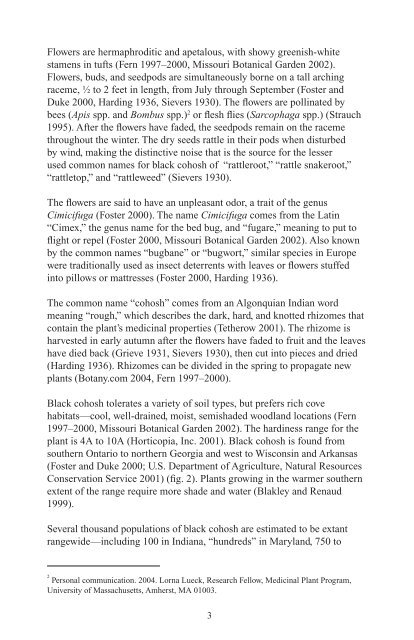Black Cohosh - Non-Timber Forest Products
Black Cohosh - Non-Timber Forest Products
Black Cohosh - Non-Timber Forest Products
You also want an ePaper? Increase the reach of your titles
YUMPU automatically turns print PDFs into web optimized ePapers that Google loves.
Flowers are hermaphroditic and apetalous, with showy greenish-white<br />
stamens in tufts (Fern 1997–2000, Missouri Botanical Garden 2002).<br />
Flowers, buds, and seedpods are simultaneously borne on a tall arching<br />
raceme, ½ to 2 feet in length, from July through September (Foster and<br />
Duke 2000, Harding 1936, Sievers 1930). The flowers are pollinated by<br />
bees (Apis spp. and Bombus spp.) 2 or flesh flies (Sarcophaga spp.) (Strauch<br />
1995). After the flowers have faded, the seedpods remain on the raceme<br />
throughout the winter. The dry seeds rattle in their pods when disturbed<br />
by wind, making the distinctive noise that is the source for the lesser<br />
used common names for black cohosh of “rattleroot,” “rattle snakeroot,”<br />
“rattletop,” and “rattleweed” (Sievers 1930).<br />
The flowers are said to have an unpleasant odor, a trait of the genus<br />
Cimicifuga (Foster 2000). The name Cimicifuga comes from the Latin<br />
“Cimex,” the genus name for the bed bug, and “fugare,” meaning to put to<br />
flight or repel (Foster 2000, Missouri Botanical Garden 2002). Also known<br />
by the common names “bugbane” or “bugwort,” similar species in Europe<br />
were traditionally used as insect deterrents with leaves or flowers stuffed<br />
into pillows or mattresses (Foster 2000, Harding 1936).<br />
The common name “cohosh” comes from an Algonquian Indian word<br />
meaning “rough,” which describes the dark, hard, and knotted rhizomes that<br />
contain the plant’s medicinal properties (Tetherow 2001). The rhizome is<br />
harvested in early autumn after the flowers have faded to fruit and the leaves<br />
have died back (Grieve 1931, Sievers 1930), then cut into pieces and dried<br />
(Harding 1936). Rhizomes can be divided in the spring to propagate new<br />
plants (Botany.com 2004, Fern 1997–2000).<br />
<strong>Black</strong> cohosh tolerates a variety of soil types, but prefers rich cove<br />
habitats—cool, well-drained, moist, semishaded woodland locations (Fern<br />
1997–2000, Missouri Botanical Garden 2002). The hardiness range for the<br />
plant is 4A to 10A (Horticopia, Inc. 2001). <strong>Black</strong> cohosh is found from<br />
southern Ontario to northern Georgia and west to Wisconsin and Arkansas<br />
(Foster and Duke 2000; U.S. Department of Agriculture, Natural Resources<br />
Conservation Service 2001) (fig. 2). Plants growing in the warmer southern<br />
extent of the range require more shade and water (Blakley and Renaud<br />
1999).<br />
Several thousand populations of black cohosh are estimated to be extant<br />
rangewide—including 100 in Indiana, “hundreds” in Maryland, 750 to<br />
2<br />
Personal communication. 2004. Lorna Lueck, Research Fellow, Medicinal Plant Program,<br />
University of Massachusetts, Amherst, MA 01003.<br />
3


